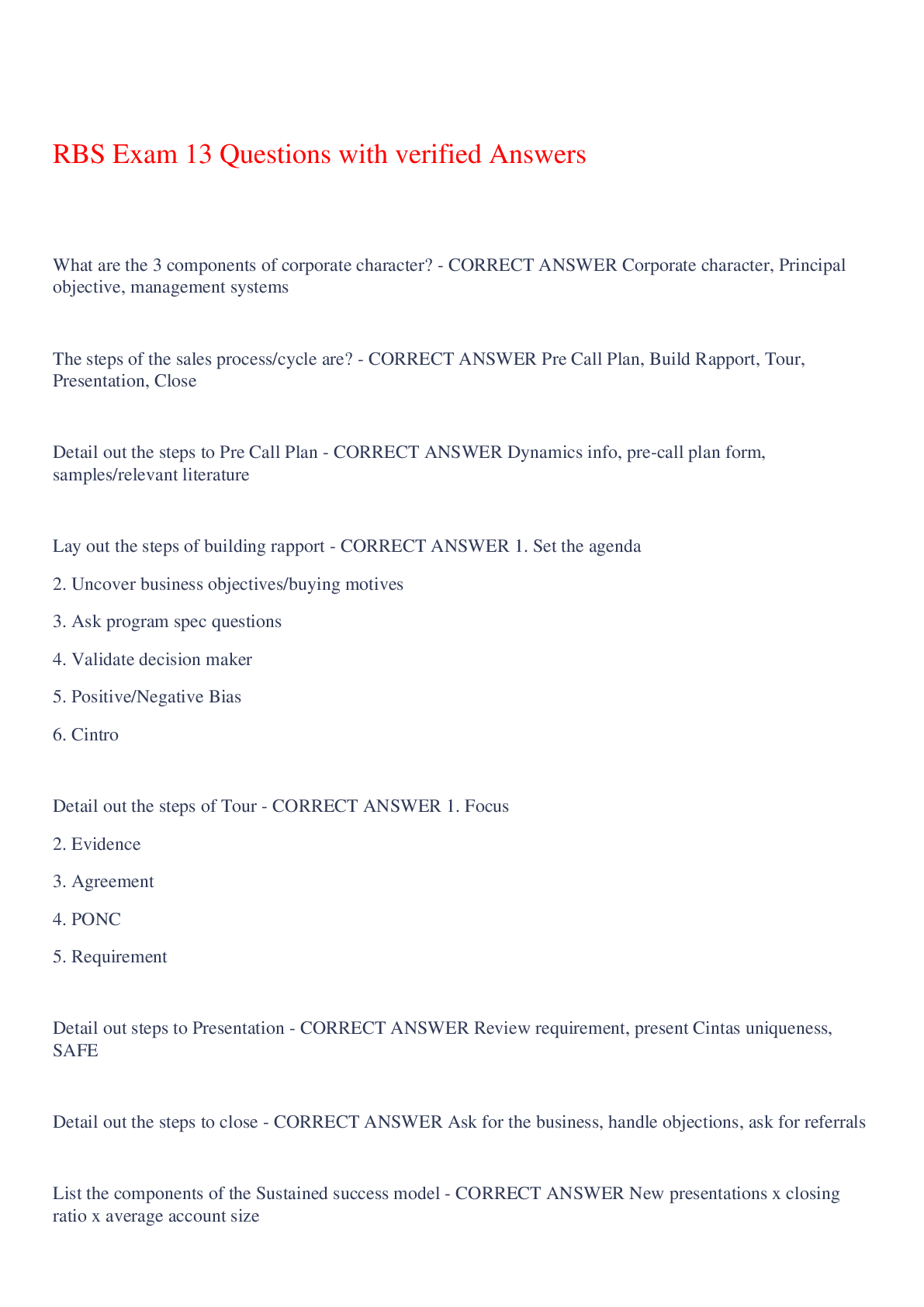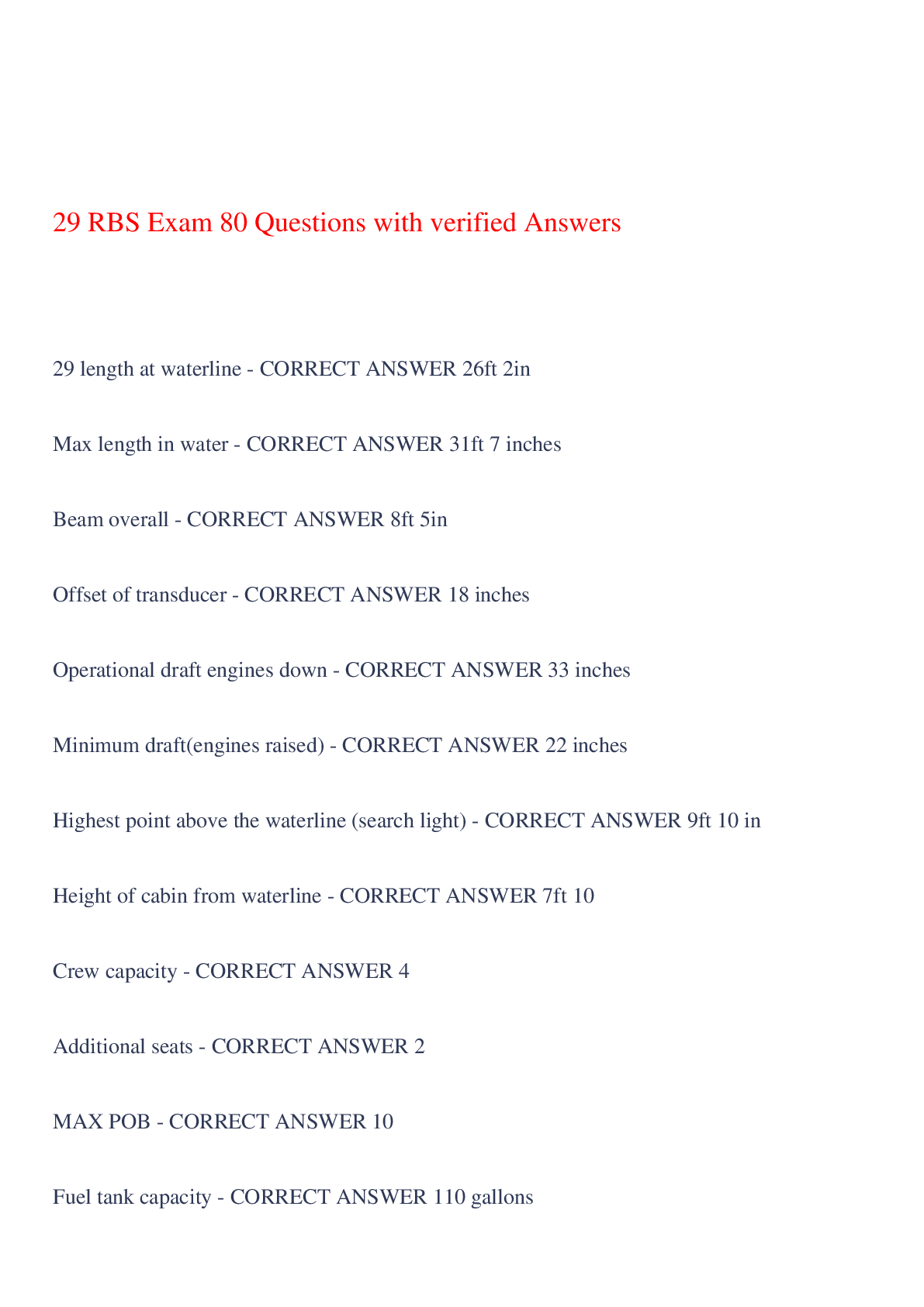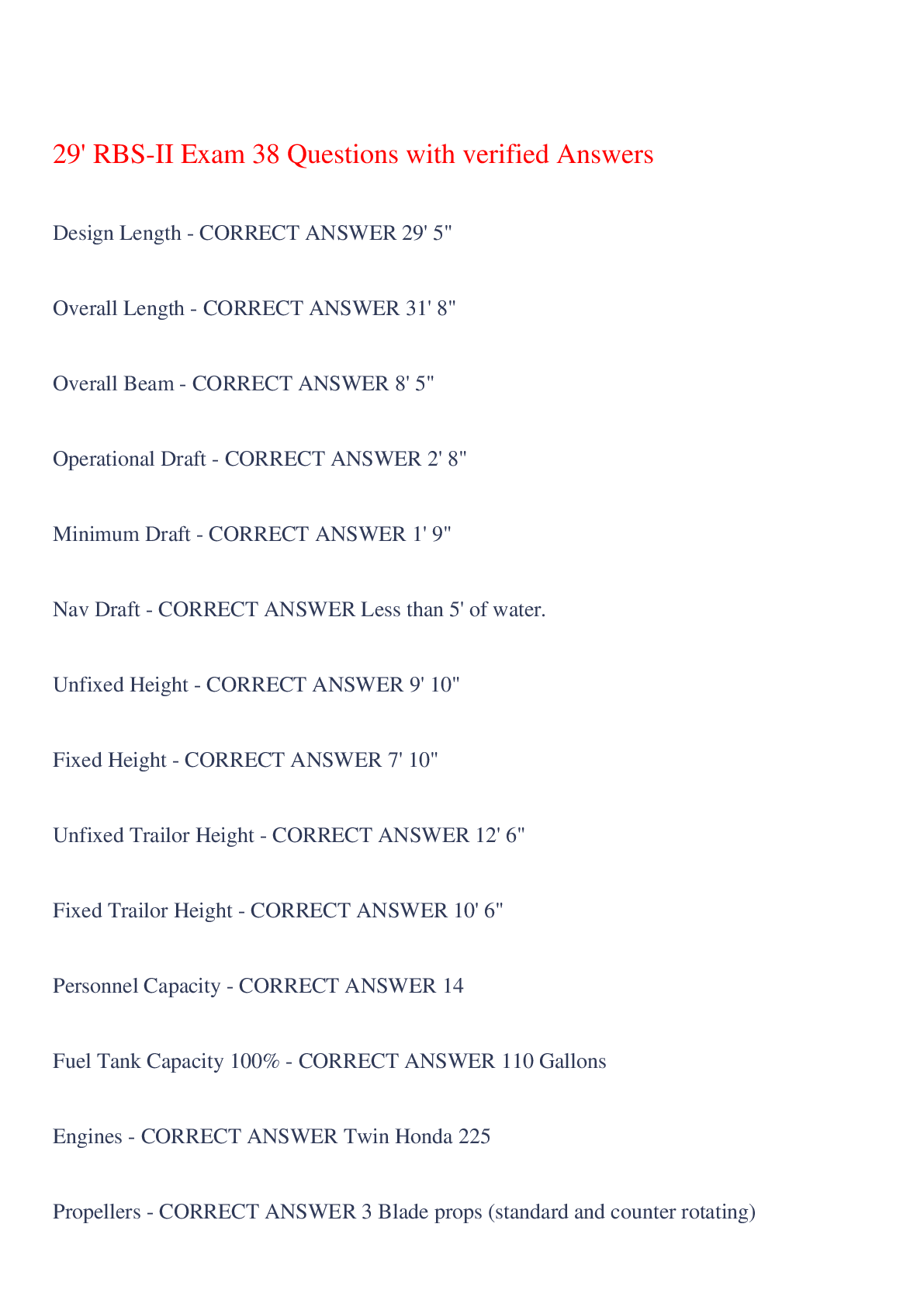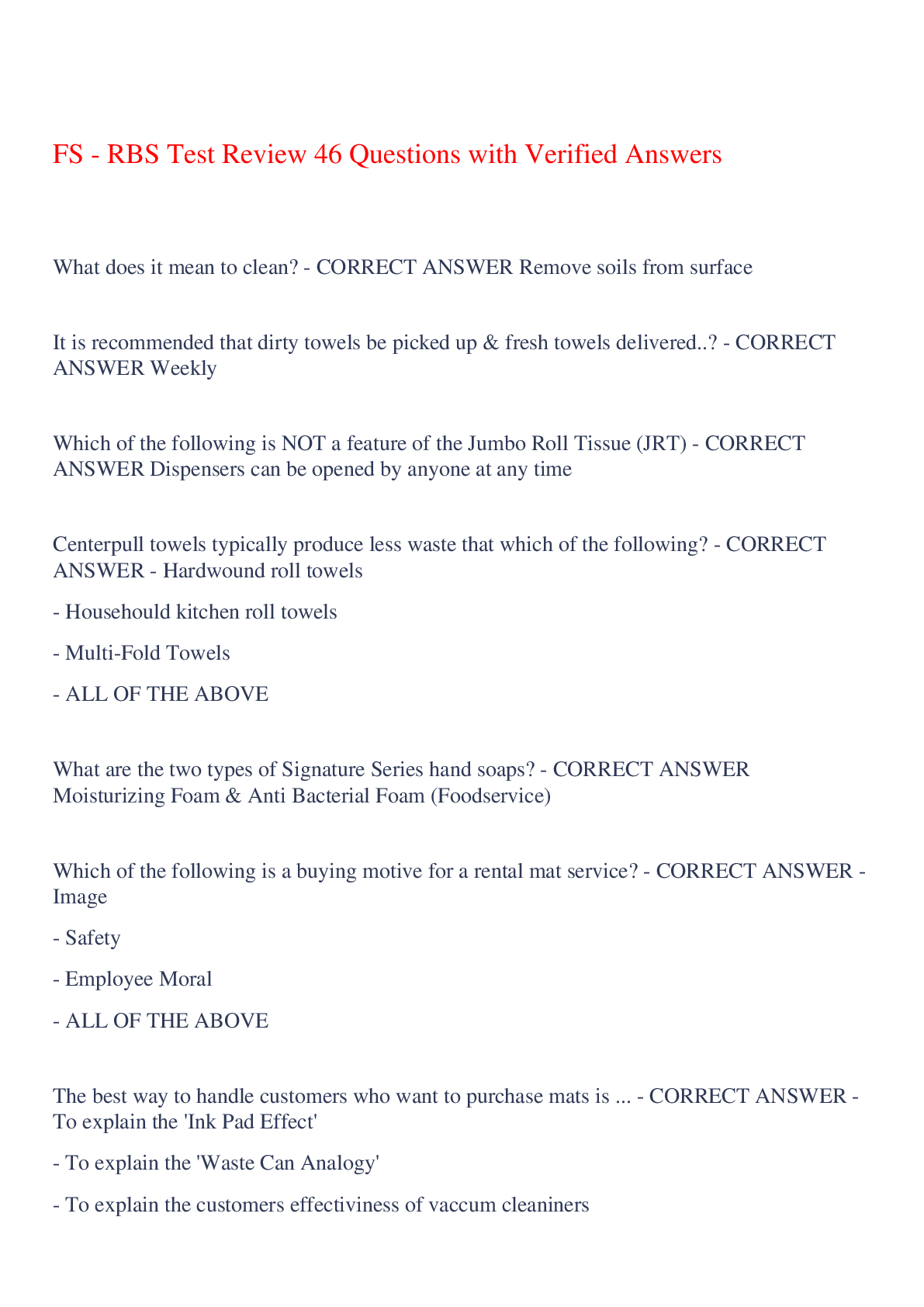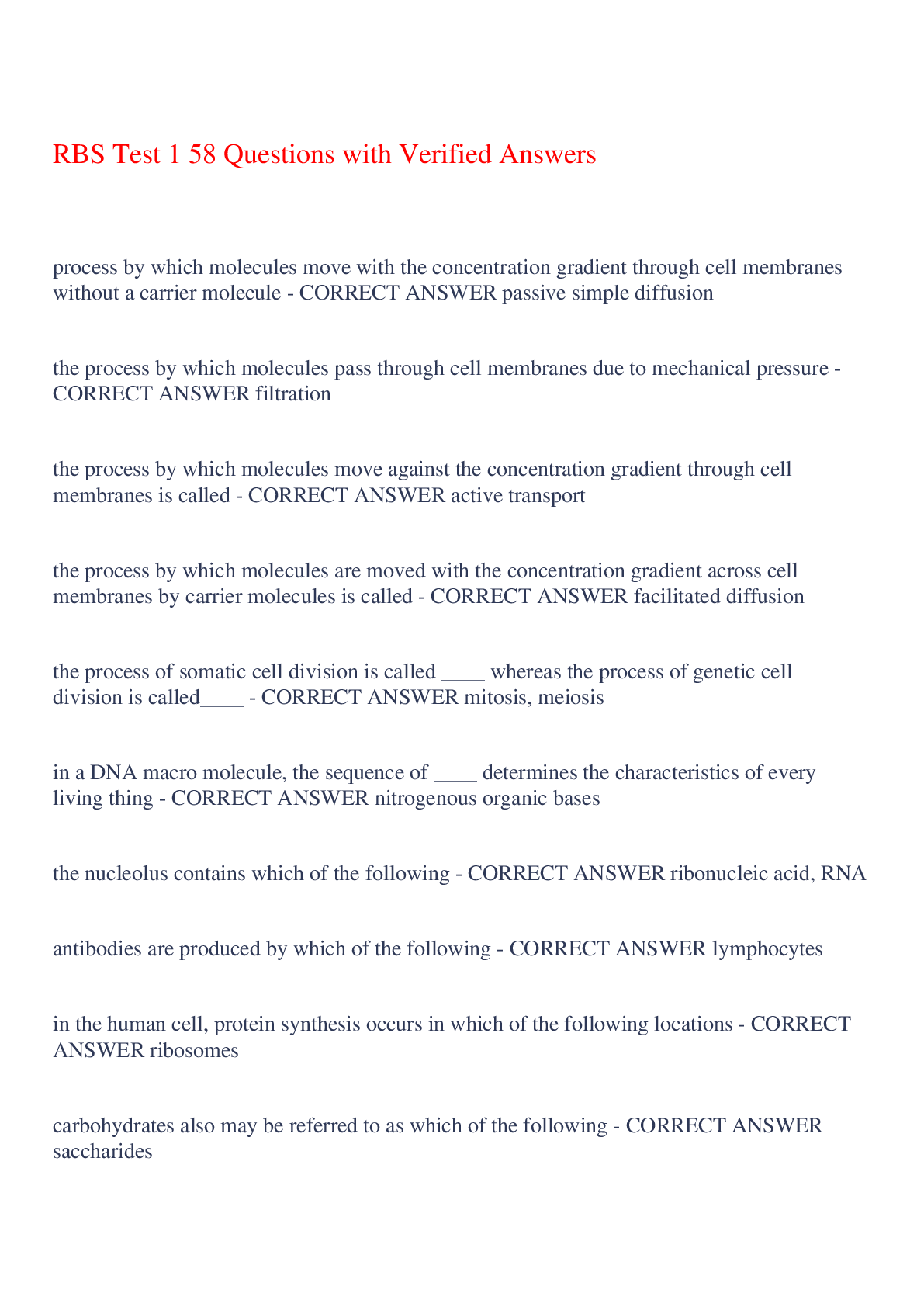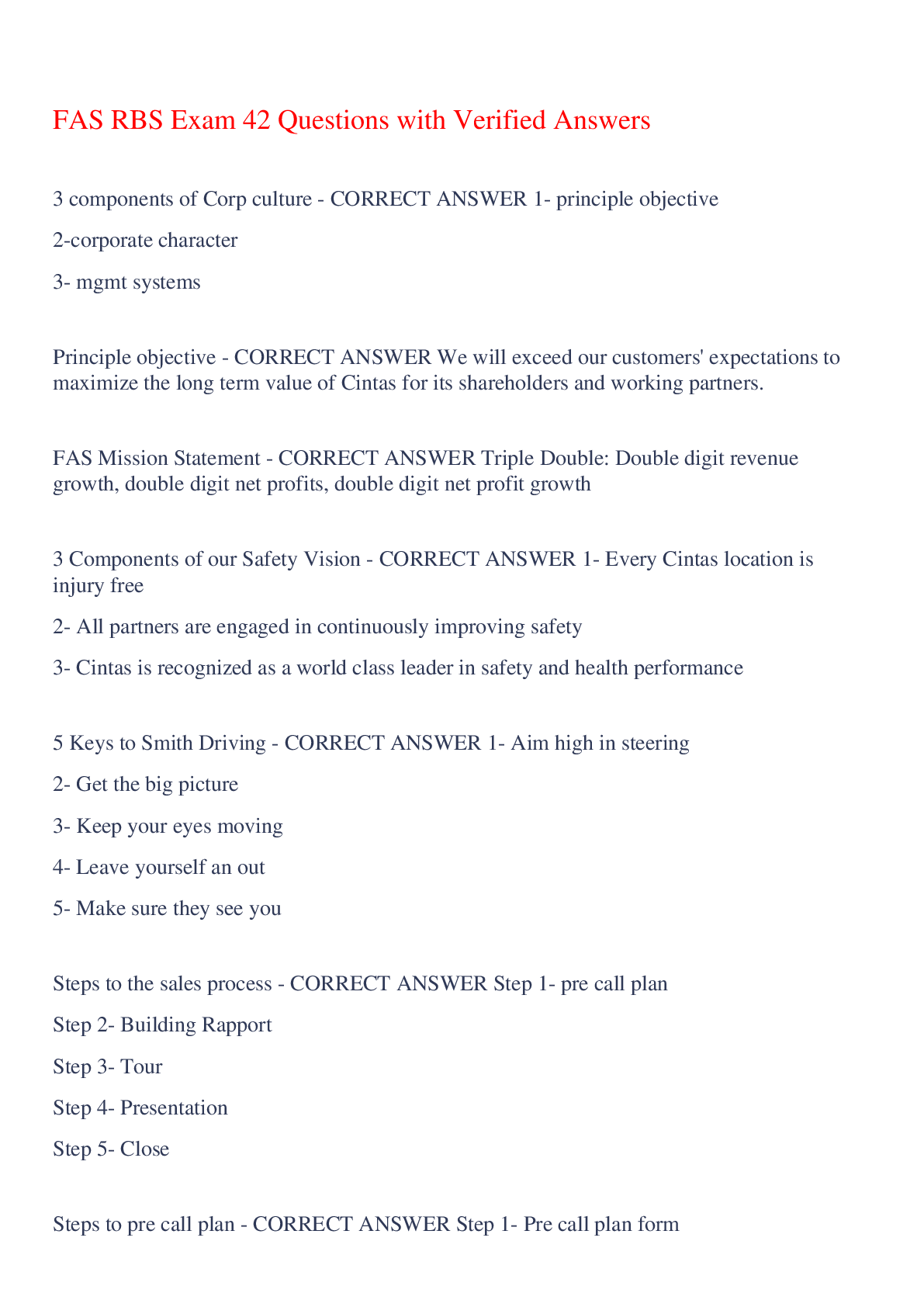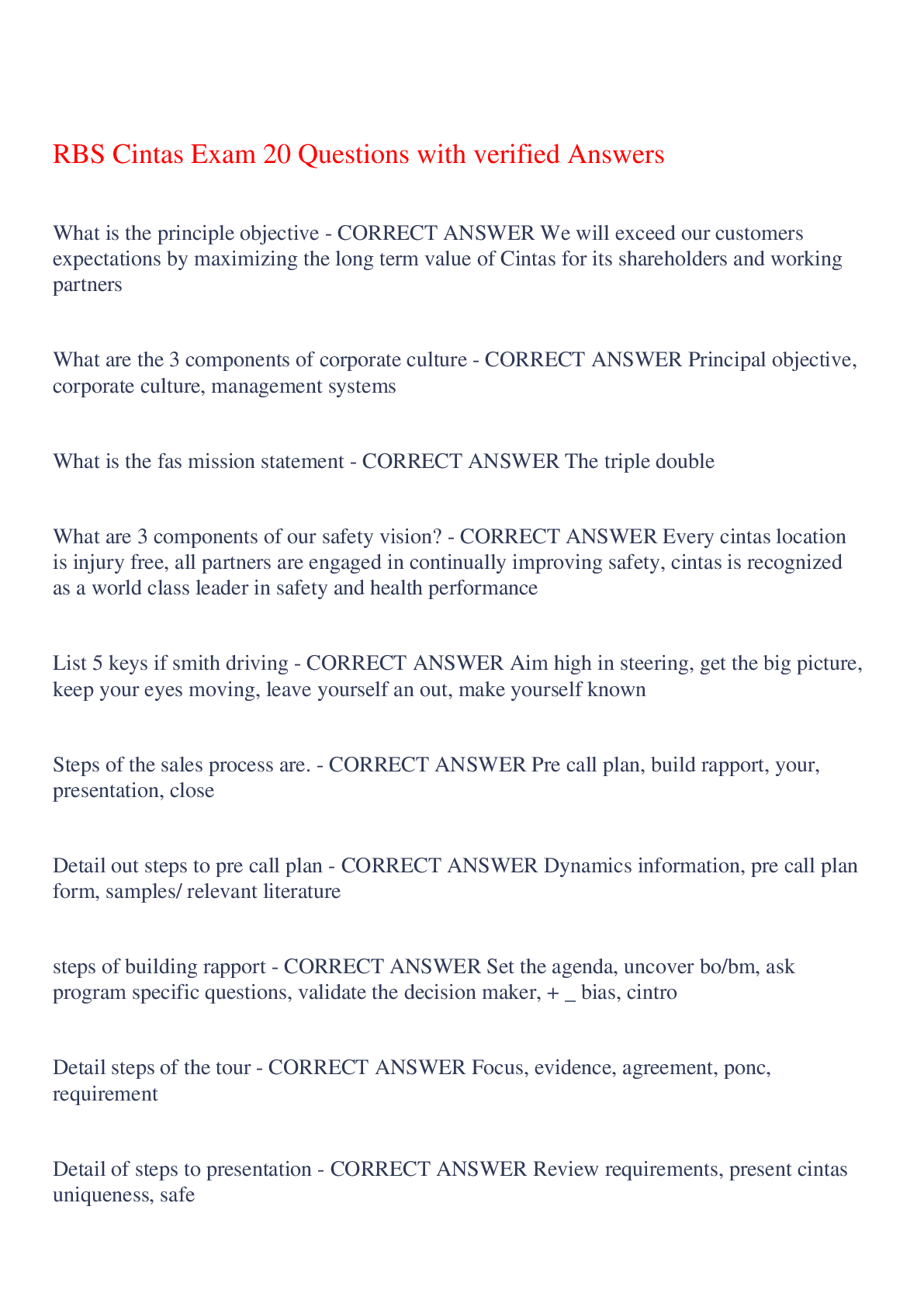*NURSING > EXAM > CHPN Certified hospice palliative nurse exam 195 Questions with Verified Answers,100% CORRECT (All)
CHPN Certified hospice palliative nurse exam 195 Questions with Verified Answers,100% CORRECT
Document Content and Description Below
CHPN Certified hospice palliative nurse exam 195 Questions with Verified Answers AIDS infection - CORRECT ANSWER Bacterial, Viral, Fungal, Parasitic AIDS dementia - CORRECT ANSWER causes Encep... halopathy, 15% effected ALS (amyotrophic lateral sclerosis) 1st symptom - CORRECT ANSWER swallowing difficulty followed by distal weakness Cerebral Metastases - CORRECT ANSWER Brain mets account for 40% of all Cancer patients. Cerebral Metastases symptoms - CORRECT ANSWER HA initial complaint, N/V, confusion, lethargy Leukemia 2 types - CORRECT ANSWER chronic and acute Leukemia Clinical Manifestations - CORRECT ANSWER Infection, fever, enlarged liver, spleen, kidneys, bleeding/bruising not explained, & hemorrhage pale, petechia, purpura liver failure symptoms - CORRECT ANSWER fatigue, jaundice, ascites Dark urine, gray stool, bruising symptoms of bleeding internally - CORRECT ANSWER sudden fever > 101°, dyspnea, abdominal paik, dehydration Lymphoma types - CORRECT ANSWER Hodgkins and Non-Hodgkins Hodgkin's disease - CORRECT ANSWER painless lymph node swelling, generally in upper body, general fatigue, weight loss, fever, nifht sweats, back pain Non-Hodgkin's Lymphoma - CORRECT ANSWER same symptoms except itching & night sweats Parkinson's disease - CORRECT ANSWER Slow progression of motor skills, resting tremors, slowness, rigidity. typically in people >65 Parkinson Signs/Symptoms - CORRECT ANSWER pill rolling movements in bands, loss of facial expression, difficulty initiating movement, gait changes Renal Cancer/symptoms - CORRECT ANSWER asymptomatic early. Gross hematuria, dull, aching pain, palpable abdomen mass. polycythemia- HA, dizzy, vein inflammation, itchy. hypercalcemia- tired, poor appetite, freq. urine, thirst, n/v, confusion, constipation, poor concentration sickle cell disease - CORRECT ANSWER pallor, jaundice, weakness, fatigue common symptoms sickle cell crisis - CORRECT ANSWER multiple pain events, pale lips, tongje, palms, nail beds, lethargy, difficulty arousing, high fever 2 days sickle cell risk - CORRECT ANSWER high r/o bacterial infections palliative sedation - CORRECT ANSWER midazolam, propofol terminal weaning - CORRECT ANSWER gradual withdrawal of mechanical ventilation terminal Extubation - CORRECT ANSWER abrupt Removal of endotracheal tube Death Rattle Meds - CORRECT ANSWER anticholinergic should be given @ 1st site of moisture. they cannot dry up secretions already present poverty barriers at EOL - CORRECT ANSWER additional challenges to EOL care. lack of support. BIPAP (non-invasive ventilation) - CORRECT ANSWER may be utilized at EOL for dyspnea in some pts who do not want to be intubated for RF but want something more than supplemental o2. ALS has been shown to improve quality of life. unhealthy coping in caregiver @ EOL - CORRECT ANSWER signs: negative feelings (anger), withholding info to other family, refusing assistance, focusing on their needs only, refusing to acknowledge or accommodate differences in opinion among caregivers. intervene with assistance/resources tricyclic antidepressants - CORRECT ANSWER tx neuropathic pain. High A/E tricyclic antidepressants A/E - CORRECT ANSWER Anticholinergic common: dry mouth, urinary retention, tachycardia, delirium, constipation additional: arrhythmias, sedation, weight gain, sweating, sexual dysfunction. *pt may refuse to continue r/t A/E myoclonus - CORRECT ANSWER jerks, sudden, brief, and uncontrollable movement. mostly upper extremity. most common cause is opiod. sign of opiod toxicity- need to change meds. Narcan for acute tx. benzos & antispasmodics can be tx in *some* pts Hypercalcemia - CORRECT ANSWER urgent & serious late stage malignancy (unrelated to bone mets). no tx results in death hypercalcemia occurrence - CORRECT ANSWER most common breast CA & multiple myeloma but can occur with others. Hypercalcemia symptoms - CORRECT ANSWER n/v, constipation, anorexia weakness, mental change, fatigue bradycardia, EKG changes Hypercalcemia treatment - CORRECT ANSWER palliative care pt: IV hydration, calcitonin (inhibits bone resorption) & biophonates (inhibits bone resorption & reduces Calcium levels)- but this is delayed to 48 hrs after administration. federal law & organ donation - CORRECT ANSWER family must be asked about donation when pts die in the hospital if there is no advanced directive outlining pts wishes Xerostomia- what is is/test - CORRECT ANSWER pasty, thick saliva cracker test: give pt cracker to eat. if pt is unable to chew & swallow w/out liquid, then test is + tongue blade: place on pt tongue & if it sticks- + measurement of saliva- sawb or pt spits into container for period of time lack of radial pulse - CORRECT ANSWER death likely to occur in a few hrs Byrock & Merrimans EOL construct - CORRECT ANSWER 6 dimensions- apply to pt & caregiver byrock & merrimans EOL dimensions - CORRECT ANSWER well-being: subjective feelings about condition, emotions (anxiety, fear, readiness, acceptance) physical: comfort level & physical distress function: ability to carry out ADLs interpersonal: degree/quality relationships & changes from caregiving transcedent: perception of meaning of life as well as spiritual/religious values *a change in 1 dimension affects other dimensions. ex: ^ pain= dec. function tasks associated with accepting finality of life - CORRECT ANSWER emotional withdrawal (decathexis). dependency & acknowledging feelings of personal loss/impending death. new self- accepts they have value personal meaning for life- life review, sharing stories, person love/forgiveness of self harpers stages - CORRECT ANSWER 1) Intellectualism (0-3 months): may feel anxiety while learning/superficial acceptance 2) emotional survival (3-6 months): over identify w/ pts situation & explore ^ discomfort, guilt, saddness, ^ emotional involvement 3) Depression (6-9 months): less intellectualism, more grief, discomfort, depression & over identify w/ pt personally 4) Emotional arrival (9-12 months): interacts w/ pt & family healthy/productive & effectively copes w/ loss 5) Deep compassion (1-2 years): acceptance of death/loss, able to express compassion, provide care with dignity/respect. Diversion signs - CORRECT ANSWER sudden change in pain, pill appearance, using more pain meds than others, isolation/refusal help Islam - Orthodox Judaism EOL - CORRECT ANSWER embalming a desecration of body Hindus and Buddhists EOL - CORRECT ANSWER get cremated Embalming - CORRECT ANSWER outside of US/Canada its typically not practiced. no health or safety reason for it. if burial is delayed the body must be refrigerated. no state requires it if pt is forgetting pain pills - CORRECT ANSWER switch to a fentanyl patch CHEOPS (children's Eastern ontario pain scale) - CORRECT ANSWER used for kids 1-7 & based on 6 characteristics (crying, facial expression, verbalization, torso, upper extremities, lower extremeties). CHEOPs scores - CORRECT ANSWER 0-2: except for crying 0-3 >4 indicates pain FACES pain scale - CORRECT ANSWER >7 years. CRIES C= Assess crying, R=requirement for O2 or O2 < 95%, I= Increased vitals (BP, HR), E= expression S= sleep Ondansetron (Zofran) - CORRECT ANSWER Indicated for Chemo- abdominal radiation induced N/V in both geriatric/peds dexamethasone may be given concurrently to potentiate effects Haldol (haloperidol) - CORRECT ANSWER indiciated for opiod induce nausea as well as chemical/mechanical induced nausea but can cause dyskinsea (uncontrollable muscle movement). Scopolamine (Transderm Scop) - CORRECT ANSWER Indicated for N/V associated with GI obstruction, peritoneal irritation, increased IP. Dronabinol (Marinol) - CORRECT ANSWER used as a second line amtimetic, more effective in young adults Ketamine (Ketalar) - CORRECT ANSWER opiod usage should be decreased by 50% bc it is a strong analgesic at low doses cause: hallucinations, nightmares. lorazepam & occasionally haldol typically given. increased secretions also occur occasionally physical dependence - CORRECT ANSWER abrupt cessation of drug & decrease in blood serum leads to w/drawl symptoms addiciton - CORRECT ANSWER lack control over drug use, compulsive drug use, craving drugs despite negative effects Tolerance - CORRECT ANSWER the diminishing effect with regular use of the same dose of a drug, requiring the user to take larger and larger doses before experiencing the drug's effect psuedoaddiction - CORRECT ANSWER mistaken belief that someone is seeking drugs for pain instead of suffering from an addiction Fentanyl (transdermal) - CORRECT ANSWER may cause skin irritatation. rotate sites, spray with a steriod used for inhalation prevents skin reaction. it dries & doesnt leave a residue or interfere with absorption. if irritation consits may need to switch pain meds. complementary therapies - CORRECT ANSWER used in conjunction with conventional medical therapies usually help reduce pain, nausea, anxiety and improve quality of life (aromatherapy, music, acupuncture, massage, yoga, biofeedback, hypnosis) homeopathy - CORRECT ANSWER believe healing must occur from inside. use of plants/minerals to promote healing. tx doesnt include active ingredients found in meds, tx rarely interact with meds. can out people @ risk if they only do homepathic Culture (EOL Care) - CORRECT ANSWER asian: value stoicism. may not express pain with moaning or complaints. northern European: fairly stoic Hispanic/middle eastern/southern European & Mediterranean: more expressive, behavior may indicate more severe pain. *all varies by person* visceral pain - CORRECT ANSWER pain that originates from organs or smooth muscles. poorly defined area. responds well to opiods visceral pain symptoms - CORRECT ANSWER squeezing, cramping, deep ache, feeling "sick"- N/V internal organs viceral pain- - CORRECT ANSWER spleen, kidney, pancreas: less receptors & feel less pain even w/ damage stomach, bladder, uterus: create significant pain from slight damage somatic pain - CORRECT ANSWER cutaneous or musculoskeletal musculoskeletal- deep somatic pain. ex would be metastatic CA surface pain: surgical incision. deep somatic pain & Surface somatic pain - CORRECT ANSWER deep: dull, throbbing ache focused on trauma area surface: on injury, think sharp, burning, or prickling sensation. Neurpathic pain - CORRECT ANSWER results from nervous system injury. CA cells compressing nerves or spinal cord, or chemical damage (radiation or chemo). other include DM oe alcohol related. neuropathic pain symptoms - CORRECT ANSWER Shooting, burning, electrical, tingling, numbness, sharp. may req. nerve block. opiods/NSAIDs typically not effective nociceptive pain - CORRECT ANSWER umbreppa for pain. 4 stages. 2 categories nociceptive pain stages - CORRECT ANSWER transduction: where change occurs transmission: where the impulse is transferred along neural path modulation or translation of signal perception by pt nociceptive pain types - CORRECT ANSWER somatic: cutaneous tissues, bone joints, muscle tissues visceral: internal organs, cardio, respiratory, GI, GU all tx with opiods breakthrough pain - CORRECT ANSWER Incident pain: tied to an activity or ecent. anticipated and tx with rapid analgesic spontaneous: unpredictable, if neuropathic- adjuvant therapy otherwise rapid pain med end of dose failure: pain occurs @ end of a routine analgesic dosing when med lowers in blood. may indicate increased dose tolerance and need for med alterations. ABCDE approach to pain - CORRECT ANSWER A: Ask about pain regularly. Assess pain systematically. B: Believe the patient and family in their report of pain and what relieves it. C: Choose pain control options appropriate for the patient, family, and setting. D: Deliver interventions in a timely, logical, and coordinated fashion. E: Empower patients and their families. Enable them to control their course to the greatest extent possible. QUESTT pain assessment - CORRECT ANSWER Q = question the child U = use pain rating scale E = evaluate behavior and physiologic changes S = secure parental involvement T = take cause of pain into account T = take action and evaluate results cultural consideration to pain - CORRECT ANSWER native American & Alaskan natives: unwilling to show pain or request meds. endured rather than tx Asian & Pacific islanders: dont vocalize pain & may use non traditional methods like acupuncture Black & African American: openly express pain but believe it should be endured. Avoid meds fear of addiction or stigmatism Hispanic culture: value ability to endure pain. expression by a male is a sign of weakness. pain is a gorm of godly punishment or trial gender consideration pain - CORRECT ANSWER women seek help sooner than men. experience more visceral pain NSAIDs - CORRECT ANSWER anti-inflammatory & antipyretuc 1st defense for inflammatory conditions A/E: GI bleed, ulcers, dec. renal, impaired platelets, short term memory in elderly cant use beyond 6-12 months *allergy to sulfa may be contraindicated * myoclonus - CORRECT ANSWER the sudden, involuntary jerking of a muscle or group of muscles. occurs opiods in high doses w/ renal failure, seizures can occur others include brain surgery, intrathecal placement, AIDs dementia, hypoxia. nocturnal is common Adjuvent - CORRECT ANSWER additional treatment after primary treatment. generally w/ opiod antidepressants, anticonvulsant, corticosteroids Ketamine- pain crisis - CORRECT ANSWER 0.1 mg/kg IV if no response follow up in 5 minutes & repeat PRN decrease opiod by 50% 1 mg/min for 70 kg person subcutaneous is possible 0.3-0.5 mg/kg consider benzo w/ to prevent hallucinations/bad dreams. if ^ secretions use glycopyrrolate, scopalamine or atropine outcome indicators for palliative care - CORRECT ANSWER Bring pain not managed within pt comfort level in first 48 hrs pain control should be maintained not controlled needs active intervention A/E should be anticipated & prevented or tx. EOL meds - CORRECT ANSWER controlling pain with meds does not shorten or expand life span. cant hasten or cause death when used responsibly methadone: common, safe, and inexpensive addiction/respiratory depression is only a concern when the pt is 1st introduced to opiod Morphine - CORRECT ANSWER No ceiling dose (often used for pt w/ CA) Different forms: IV, IM, IR, SR, Long-acting, liquid, suppositories s/e: sedation, respiratory depression, itching, nausea, chronic spasms, twitching, constipation after a few days pts overcome itching, nausea, Resp depression, sedation Meperidine (Demerol) - CORRECT ANSWER discourage use no long term effect, only lasts 2-3 hrs. repeated doses can lead to CNS toxicity r/t ineffective netabolite clearance. especially renal pt lead to muscle twitching, new onset seizure, increased pain/sensitivity not easily reversed & doesn't respond to narcan oral fentanyl - CORRECT ANSWER on an oral applicator, pt applies dose (typically 200 mcg) to buccal mucosa between cheek/gum for rapid absorption. useful for breakthrough pain, relief begins in 5 min. wait 15 min before repeating swallowing effects timing= peak occurs 20- 40 min. & lasts 2-3 hrs s/e: somnolence, nausea, dizziness. coffee, tea, and juice can effect pH and absorption Oxycodone - CORRECT ANSWER moderate to severe pain S/E similar to morphine w/ N/V cannot be crushed or cut due to ER can be hestiation from pt due to poor perception from public use cautiously in pt w/ hypothyroidism, addisons disease, urethral stricture, prostatic hypertrophy, or Lung/liver disease Methadone (Dolophine) - CORRECT ANSWER tx chronic or severe pain. helpful neuropathic pain long acting but exact doses remain unclear absorption can be easily affected by other meds tx opiod addiction for pain needs to be clearly stated cause drowsiness, HA, N/V, constipation, sweating, flushing, sedation, dec. RR, irregular HR Hydromorphone (Dilaudid) - CORRECT ANSWER tablets, liquid, suppository, parental synthetic so can be used w/ morphine allergy control cough neurotoxicity can occur especially myoclonus, hyperalgesia, seizures use caution kidney, liver, heart, thyroid, seizures, respiratory disease, prostatic hyperplasia, urinary issues S/E: dizzy/lighthead, drowsy, upset stomach when taken w/out food, Vomits, constipation Ketorolac (Toradol) - CORRECT ANSWER NSAID used for analgesic, antipyretic, ans anti-inflammatory properties short term therapy of 5 days or less only NSAID available oral, IM, opthalmic contraindicated renal issues s/e: edema, HTN, rash, nausea, constipation, diarrhea, vomiting, drowsiness, dizziness, HA complications: ulcer, bleeding, perforation, renal damage, hemorrhage Doses for enteral & parental - CORRECT ANSWER morphine: enteral 30mg (ER) last 12-24 hrs. parental: 10mg codeine: Enteral 7.5 lasts 24 hrs. parental 130mg hydromorphone: enteral 7.5mg lasts 24 hrs. parental 1.5mg levorphanol: enteral 4mg, parental 2mg. chronic pain 1mg for both. long 1/2 life Calculations for dose conversion - CORRECT ANSWER current 24 hr dose multiplied by: new drug 24 hr equiv dose ÷------------------------------ ÷ current drug 25 hr equiv dose = new 24 hr dose new 24 hr dose ÷---------------÷ = new dosage doses per day tx neuropathic pain - CORRECT ANSWER 3 drug classes: anticonvulsant, anesthetics, antidepressants some are PRN but most scheduled meds: amitriptyline, nortriptyline, duloxetine, gabapentin, topical lidocaine, opiods, & pregabalin bone pain - CORRECT ANSWER opiods & NSAIds/COX-2 inhibitors used. morphine + ibuprofen common others surgery removal tumor, targeted chemo/radiation hormone therapy estrogen/androgen CA HIV/AIDS pain sources - CORRECT ANSWER 1) Apthous: Canker sore, ulcer & oral candidiasis 2) Arthalgia: joint pain w/ heat, redness, loss motion 3) Hepatoxicity: liver damage (N/V/D, jaundice 4) Herpes 5) Isoporiasis: diarrhea, fever, HA 6) Myalgia: muscle pain/general 7) neuralgia/neuropathy: chronic 8) Pancreatitis 9) Shingles: Varicella zoster (VZV) 10) SJS (steven Johnson syndrome): severe-fatal skin rash w/ red blistered and painful spots Acetaminophen (Tylenol) - CORRECT ANSWER safest long term use tx mild pain or as an adjuvant good for arthritis, musculoskeletal pain limited anti inflammatory nature caution w/ renal/liver, ETOH abuse dose separately from opiod agitation - CORRECT ANSWER calm environment most effective re-orient Anxiety roots - CORRECT ANSWER 1) Cardo: MI, angina, CHF, etc. 2) Endo: Blood sugar, thyroid 3) Metabolic: Potassium, anemia 4) Neoplasm: Adenomas, carcinoma 5) Neuro: Seizure, vertigo, lesions, encephalopathy 6) Resp: Hypoxia, asthma, COPD ascites - CORRECT ANSWER abnormal accumulation of fluid in the abdomen. tx: restrict sodium & fluid Ascites Treatment - CORRECT ANSWER Spironolactone and furosemide (100:40) or (400:80) dehydration can occur from lasix & encephalopathy, prerenal Failure mixed ascites - CORRECT ANSWER dietary changes are needed in addition to dec. fat intake, increase triglycerides. refractory ascites - CORRECT ANSWER type of ascites that is unresponsive to Na-restricted diet and high dose diuretic treatment or recurs rapidly after successful tx. paracentesis rec. associated w/ cirrhosis or malignantcy paracentesis - CORRECT ANSWER 4-6 L removal per day safe with albumin infusion to prevent hypovolemia peritoneovenous shunts (Denver or LeVeen) helpful 75-85% pt w/ non malignant ascites -asthenia - CORRECT ANSWER weakness, debility azotemia - CORRECT ANSWER (excessive) urea and nitrogenous substances in the blood sign of renal Failure- insufficient filtering CHF, shock, burns, vomiting/diarrhea, liver failure, trauma to kidney, anti viral meds s/s: dec. urine output, thirst, edema, pale skin, rapid oulse, ortho BP tx: hemodialysis, peritoneal Bowel symptoms - CORRECT ANSWER Strangulation: Severe steady pain Lg obstruction: cramps lower abdomen, bloat. Sm obstruction: cramping, coliky pain, middle to upper abdomen vomit/green vomit. constipation & no gas. diarrhea w/ partial cahexia - CORRECT ANSWER malnutrition, wasting, and emaciation. equal loss of fst and muscle. doesn't respond to nutritional supplements or increased intake. CHF - CORRECT ANSWER CAD most common cause symptoms: weight gain, peripheral edema, nocturia, dec. urine output, SOB,wheezing, anxiety, cyanosis, fainting heart murmors may be present, crackles in lungs, enlarged liver left heart failure - CORRECT ANSWER The heart does not adequately circulate blood to systemic system. Due to pressure overload or volume overload. symptoms: SOB, edema, pulmonary congestion Right heart failure - CORRECT ANSWER The heart does not adequately circulate blood to the pulmonic system. Can be due to volume overload or regurgitation in Tricuspid Valve or Pulmonic Valve. Can lead to systemic edema, back up of blood in liver and lower extremities. symptoms: ascites, JVD, edema cystic fibrosis - CORRECT ANSWER A genetic disorder that is present at birth and affects both the respiratory and digestive systems. fatal sweat w/ electrolytes complications: nasal polyps, bronchiectasis, pneumonia, RF, malabsorption, pancreatis, peptic ulcer, rectal prolapse, DM, arthritis, FTT, delayed puberty live 20s-30s & occasionally 40s tx: prevent infection Dehydration - CORRECT ANSWER Hyponatremic: anorexia, weight loss, N/V. dry mouth, ortho BP, delirium, seizure, coma hypernatremic: thirst, fever, fatigue, muscle weakness, LOC change. sodium ^ Isotonic: aggression, apathy, demoralization, lack coordination. no lab studies Conflict Negotiation - CORRECT ANSWER identify source of conflict address conflict identify individuals purpose problem solve Kane issues when team doesn't agree - CORRECT ANSWER overwhelming the pt patient participation suppressing team members lack of accountability team process over client outcome orthodoxy & grouplink (closed 2 new ideas and input) overemphasis on health safety/goals resources allocation Robert Woods - CORRECT ANSWER grant for education SUPPORT study to understand prognosis and preferences for outcomes & risks of tx findings: people suffering for no reason, dr./nurse didnt understand EOL, def family is changing, nursing shortage=strain, communication needs improved National concensus project (NCP) - CORRECT ANSWER palliative care, Clinical guidelines, practices, key elementd, quality recognition/growth nurses encouraged to participate clinical practice guidelines - CORRECT ANSWER dont specify protocol for pain or symptom management NCP Domains - CORRECT ANSWER 1) structure & practice of care- IDT commitment & team support 2) Physical- pt symptoms are addressed/educated, care plan 3) Psychological & psych: grief, bereavement addressed 4) social: finances, support, etc. 5) Spiritual/religious etc. 6) cultural 7) EOL pt care: referalls, education 8) Ethics & Law Ethics - CORRECT ANSWER the principles of right and wrong that guide an individual in making decisions euthanasia - CORRECT ANSWER the act of painlessly killing a suffering person or animal; mercy killing illegal in 50 states differs from assisted suicide bc pt carries out act- legal in Oklahoma conscientious objection - CORRECT ANSWER A personal appeal that to carry out a particular action that has been ordered by legitimate authority would be against one's own conscience. (abortion, assisted suicide). nurse has to ensure pt isn't abandoned. no special permission from board is granted CARES Model- burnout - CORRECT ANSWER C- creation of community A- awareness of s/s R- reinforcement self care E- emphasis on health S- spiritual awareness Nursing role research - CORRECT ANSWER still evoling in EOL care needed: specialized area of physical, psycho-spiritual, social dimensions of EOL care Future Trends - CORRECT ANSWER alzheimers may increase from 4 mil-14 million by 2050 nursing shortage will cont. EOL cont. to expand Dementia - CORRECT ANSWER irreversible loss of intellectual functioning caused by organic brain damage or disease complicated by delirium Anomia - CORRECT ANSWER inability to name objects Agnosia - CORRECT ANSWER the inability to recognize familiar people aphasia - CORRECT ANSWER impairment of language, usually caused by left hemisphere damage either to Broca's area (impairing speaking) or to Wernicke's area (impairing understanding). Apraxia - CORRECT ANSWER impaired ability to carry out motor activities despite intact motor function Dementia medications - CORRECT ANSWER Donepezil (Aricept) Rivastigmine (Exelon) Memantine (Namenda) tacrine, Gingko decreasing bladder contractility - CORRECT ANSWER meds that dec freq. urination 1) Tolterodine 2-4mg 2) Trospium 20mg 3) Oxybutynin 5-15 mg or 7.5-15 mg 4) propantheline 7.5- 30 mg 5) hycosamine 0.125-0.375 mg 6) Dicyclomine 10-20 mg 7) Flavoxate 100mg 8) Belladonma or opium suppository s/e: dry mouth, flushing, constipation, drowsiness, blurred vision DIAPERS mnemonic for incontinence - CORRECT ANSWER D- delirium I- Infection A- Atrophic Urethritis P- Pharmacy E-Excessive urine production R- Restricted mobility S- Stool impaction Diarrhea treatment - CORRECT ANSWER small bland meals, ^ fluids, low residue diet w/ K rich foods ginger, tea, glutamine, peeled apples edema - CORRECT ANSWER 1+= barely detectable 2+= slight indentation 3+= deep indentation 5-30.sec. 4+= depression 1.5-2 x greater left untreated it can lead to lymphedema lymphedema - CORRECT ANSWER swelling due to an abnormal accumulation of lymph fluid within the tissues enteral complications - CORRECT ANSWER dehydration, aspiration, diarrhea, dumping syndrome expressive aphasia - CORRECT ANSWER The inability to produce language ( despite being able to understand language). broca remove distractions communication board is helpful eye blink yes or no fatigue medications - CORRECT ANSWER methylprednisolone- ^ pt activity methylphenidate- CA modafinil- MS Hydrocortisone Epoetin alfa- anemia based antidepressants- ylines CNS stimulate- dextroamphetamines use caution hemoptysis - CORRECT ANSWER coughing up blood mild- <20 mL mod- 20 but < 200 massive- 200-600 & fatal in 85% r/o asphyxiation from blood clots Hemorrhagic cystitis - CORRECT ANSWER Bleeding of the bladder tx: Aminocaporic acid- 5mg initially followed by 1-1.25g r/o clot retention. takes 8-12 hrs Silver nitrate & alum: irrigation & takes 21 hrs complete formalin: rapid, painful req. anesthesia. cause fibroids, necrosis, fistula, peritonitis hiccups/ tx - CORRECT ANSWER spasm of the diaphragm breath holding, paper bag, compression, sneeze/cough, ice, gag, bread, sugar, peppermint, rectal massage, fasting, NG or vomit intractable hiccups - CORRECT ANSWER hyponatremia, lesions create spasms. chlororomazine 25mg PO or rectum TID baclofen, midazolam, gaba, haldol, lidocaine, dexamethasone Hypercalcemia - CORRECT ANSWER excessive calcium in the blood 10% CA pt, breast/myeloma irreversible renal damage, coma, & deafh symptoms: fatigue, lethargy, nausea, polyuria, & confusion (Nausea + poly can cause dehydration ^ Ca in blood) tx: hydration w/ saline, bisphosphonate, diuretics, glucocorticoids Illeus - CORRECT ANSWER the partial or complete blockage of the small and/or large intestine painless typically but can cause constipation, cramps, fecal vomit, distention, atrophy operative anesthesia and opiod common causes may resolve self in 2-3 days, encourage oral intake prior to BoSo Monitor for dehydration, BP chsnges, focus should be on resolving issue or rectal tube to decompress CA related ascites - CORRECT ANSWER Ovarian, endometrial, breast, colon, pancreatic. block peritoneoum r/t tumors called chylous ascites Neutropenia - CORRECT ANSWER deficiency of neutrophils less 500 nothing to fight infection can cause sepsis, up to 70% pt experiencing fever will die within 48 hrs w/out aggressive tx pericardial effusion - CORRECT ANSWER accumulation of fluid or tumor cells in the pericardial cavity 20% occur lung CA associated w/ breast, leukemia, & lymphoma CA s/s: depends on how quick byt chest heavy, dry cough, weak, tachycardia pleural effusion - CORRECT ANSWER fluid in the pleural space can be slow or rapid dyspnea results from collapsed lung, dry cough, malaise, heavy Pneumonia treatment - CORRECT ANSWER pneumocystis carini- aids Trimethoprimsulfamethozazole (TMP-SMZ).1st line tx pressure ulcer stages - CORRECT ANSWER STAGE 1- Nonblanchable erythema of intact skin, the heralding lesion of skin ulceration, alteration of intact skin- STAGE 2 Partial thickness skin loss involving epidermis, dermis, or both. The ulcer is superficial and presents clinically as an abrasion, blister, or shallow crater. STAGE 3 Full thickness skin loss involving damage to or necrosis of subcutaneous tissue that may extend down to, but not through, underlying fascia. The ulcer presents clinically as a deep crater with or without undermining of adjacent tissue. STAGE 4 Full thickness skin loss with extensive destruction, tissue necrosis, or damage to muscle, bone, or supporting structures (e.g., tendon, joint capsule). seizure - CORRECT ANSWER diazepam, lorazepam, midazolam, phenytonin, phenobarbital 1st line- ativan diazepam/phenobarbital can be given IM. dia- rectal status epilepticus - CORRECT ANSWER a prolonged seizure or situation when a person suffers two or more convulsive seizures without regaining full consciousness emergency. lorazepam 1st line if no response in 5-7 min. move to next stomatitis - CORRECT ANSWER inflammation of the oral cavity including tongue, lips, etc. Superior vena cava syndrome - CORRECT ANSWER Progressive occlusion of the superior vena cava that leads to venous distention of upper extremities and head symptoms: HA, face edema, hoarseness, dyspnea, swollen arms. can be gradual or acute physical findings: distention neck/chest, cyanosis, tachypnea, orthopnea, hoarseness, nasal stuffiness, face edema eventually stupor, coma, & death BREATHS dyspnea - CORRECT ANSWER B- Bronchspasm- albuteral/steroid R- Rales/Crackles- dec. fluid. lasix 100mg E- effusion: Physical exam/chest x-ray A- airway obstruction: aspiration, upright, pureed T- tachypnea- opiod use, tx anxiety too H- hemoglobin- low consider transfusion E- education- support pt/fam S- secretions- copious do tx Diet - CORRECT ANSWER Pureed: blender w/ liquid, smooth, no chewing (applesauce, yogurt, mashed pot) mechanical alt: ground or finely chopped. minimal chew. (pasta, eggs, cottage cheese) soft diet: naturally soft Megestrol acetate - CORRECT ANSWER appetite stimulant breast/endo CA 40mg 4x daily, max out 800 rare allergy can occur, jaundice, ^ BP Haloperidol - CORRECT ANSWER Antipsychotic blocks dopamine agitation nausea by opiod, chemical, or mechanical w/ corticosteroids helpful for chemo 0.5-5mg orally 6-24 hrs 5mg IM 3-4 hrs elderly lower dose to start s/e: muscle contractions, poor muscle movement/loss. tx: schizophrenia, psychotic states, mania caution: parkinsons w/drawl: dry mouth, constipation, tremors, anxiety, nausea, mania Dressings - CORRECT ANSWER Alginate: heavy drainage/remove easily Enzymatic: loosens necrotic tissue. minimal- no discomfort semipermeable film: no drainage/no absorption, assist w/ healing, minimizes pain r/t nerve endings. can be painful bc it sticks to wound Hydrocoilloid: Absorb sm amounts, mild detriment, can cause pain chemotherapy - CORRECT ANSWER Alkaline- Hodgkins, lymphoma, lung, breast, prostate, ovary Nitro: brain tumor, lymphoma, multiple myeloma/malignant Antitumor: broad Plant Alka: Leukemia, Hodkins/non, neuroblastoma, wilm tumor, lung, breast, teste steroid: hormone like ovary Chemotherapy side effects - CORRECT ANSWER 1. bone marrow suppression 2. nausea and vomiting 3. altered immunologic response 4. impaired oral mucous membrane 5. stomatitis 6. fatigue palliative chemotherapy - CORRECT ANSWER chemotherapy that is given to relieve pain or other symptoms of cancer but not to cure it palliative care - CORRECT ANSWER Care designed not to treat an illness but to provide physical and emotional comfort to the patient and support and guidance to his or her family. Medicare Hospice - CORRECT ANSWER Medicare covers all hospice-related expenses , including meds related to disease disenfranchised grief - CORRECT ANSWER A situation in which certain people, although they are bereaved, are prevented from mourning publicly by cultural customs or social restrictions. anticipatory grief - CORRECT ANSWER a period of mourning when the dying person or his family is expecting the death Maugens SPIRIT - CORRECT ANSWER s- spiritual- religious affiliate? p- personal- practice/beliefs accept I- integration- community R-ritual- practice or restrictions affect healt? I- Implication- spiritually keep in mind T- terminal events- prepare EOL how does faith impact decisions ? HOPE - CORRECT ANSWER H-hope- sources do you have? O- organized- religion or faith? P- personal- spiritual practice helpful to you? E- Effects- beliefs & medic care? FICA - CORRECT ANSWER F—Faith or belief I—Importance and Influence C—Community A—Address (Interventions to address) girgis and sanson bad news delivery - CORRECT ANSWER 1) provide privacy & adequate time 2) assess understanding 3) provide info simply and honestly 4) avoid euphisms 5) encourage expression of feelings 6) empathetic, quiet/listen 7) nroad realistic time frame progression 8) arrange review or follow up medical futility - CORRECT ANSWER the alleged pointlessness or ineffectiveness of administering particular treatments Double Effect Principle - CORRECT ANSWER The principle that recognizes that ethical choices may result in untoward outcomes. 4 things need to be present 1) Morally good 2) Intent good 3) good is obtained w/out use of dire needs 4) balance of good is greater than anticipated negative effects Malcom Knowles - CORRECT ANSWER adult learning theory we are autonomous & self directed goal orientated practical attentive listening - CORRECT ANSWER listening actively, using all the senses, as opposed to listening passively with just the ear SIADH - CORRECT ANSWER syndrome of inappropriate antidiuretic hormone secretion causes dilutional hyponatremia caused from tumor, pneumo, pneumonia, lung disorders, meds s/s: N/V, cramps, LOC vhange, stupor, seizures at death - CORRECT ANSWER gently apply pressjre on eyelids to close them roll towell to try to close the mouth dont put dentures in- send w/ funeral subcutaneous infusion hypodermoclysis - CORRECT ANSWER 100 ml/hr 1500 mL can be admin into 1 site abdomen or lateral thighs complications: sloughing, infection, third spacing, irritation, bleeding Right hemisphere stroke - CORRECT ANSWER doesnt interfere w/ language skills,.speak normal results L paralysis-issues judging distance fine motor skills impacted like dressing impulsive and poor judgement, often denying impairments depression & short term memory Left side stroke - CORRECT ANSWER Paralysis on the right side of the body Speech/language problems Slow, cautious behavioral style Memory loss phases of swallowing - CORRECT ANSWER Oral phase: drooling, diff swallowing, food/liquid remain in mouth Pharyngeal phase: chokes while swallowing and regurgitates food into nose during meal or immediately after. guegling, caught in throat feeling Esophageal phase: reflux, regurgitates food frequently after eating, diff swallowing solid foods, rarely chokes or coughs, food stuck in chest feeling Varient angina - CORRECT ANSWER longer duration, can occur at rest, same time each day, caused by coronary artery spasm. no damage nitro or CCB uses to rx Virchow's triad - CORRECT ANSWER risk factors for thromboembolism: venous stasis, endothelial injury, hypercoagulable state initially pt asymptomatic aching. thrombing pain, + Homans (pain in calf when doesiflexed), erythema/edema, dilation vessels, and cyanosis Pilocarpine (Pilocar) - CORRECT ANSWER increases saliva production result in ^ sweat, nausea, flushing, cramping acupuncture occasionally works for some Stimulant laxatives - CORRECT ANSWER Senna 2 tabs HS best for opiods high air mattress - CORRECT ANSWER promotes evaporation of moisture. reduce heat & shear Hydrocolloid dressing - CORRECT ANSWER stage 2 with absorption sm-med exudate. leave on 2-5 days ^ r/o anaerobic infection Semi-permeable - CORRECT ANSWER dry wounds Aliginate dressing - CORRECT ANSWER large drainage QUAPI - CORRECT ANSWER facility identifies * 1) designs and scopes 2) governance and leadership 3) feedback, data, monitoring 4) PIP 5) systemic analysis and action cost minimization - CORRECT ANSWER 2 tx are equal in effectiveness but 1 cost less, the lesdt expensive one should be used Cost effectiveness - CORRECT ANSWER compares tx & assigns $ value to each yr of life gained by tx Cost utility - CORRECT ANSWER similar to effectiveness but estimates value in quality of life cost-benefit - CORRECT ANSWER monetary value of life, assigning $ value to life is difficult, seldom used Primary apsects EBP - CORRECT ANSWER Clinical expertise, available research, pt values fractionated external beam radiation - CORRECT ANSWER tx spinal cord compression bc inhibits tumor growth allows ability to walk be regained ABCDE - CORRECT ANSWER believe pt pain report is accurate (Empower) Opiod Conversion Hints - CORRECT ANSWER • Oral/rectal same • MSO4 = 1:3 (IV to oral) • Fentanyl: 50% of TDD oral morphine (25 mcg fentanyl is 50 mg MSO4 TDD) • Hydromorphone 5:1 or 3.7:1 (M:HM) • Oxycodone 1.5:1 (M:O) • Tramadol 10:1 (T:M) [Show More]
Last updated: 7 months ago
Preview 1 out of 30 pages
Instant download

Buy this document to get the full access instantly
Instant Download Access after purchase
Add to cartInstant download
Reviews( 0 )
Document information
Connected school, study & course
About the document
Uploaded On
Nov 06, 2023
Number of pages
30
Written in
Additional information
This document has been written for:
Uploaded
Nov 06, 2023
Downloads
0
Views
96














